The AM Split form will allow you to create transactions that splits an Asset from an existing Asset. The new Asset will retain a proportion of the original Asset while the original Asset retains the portions that are not split off. This functionality can be used to split existing Assets into components or to split off a proportion of an Asset prior to disposal.
The AM Split form can be accessed by selecting the Financials option on the Financials Web Main Menu:
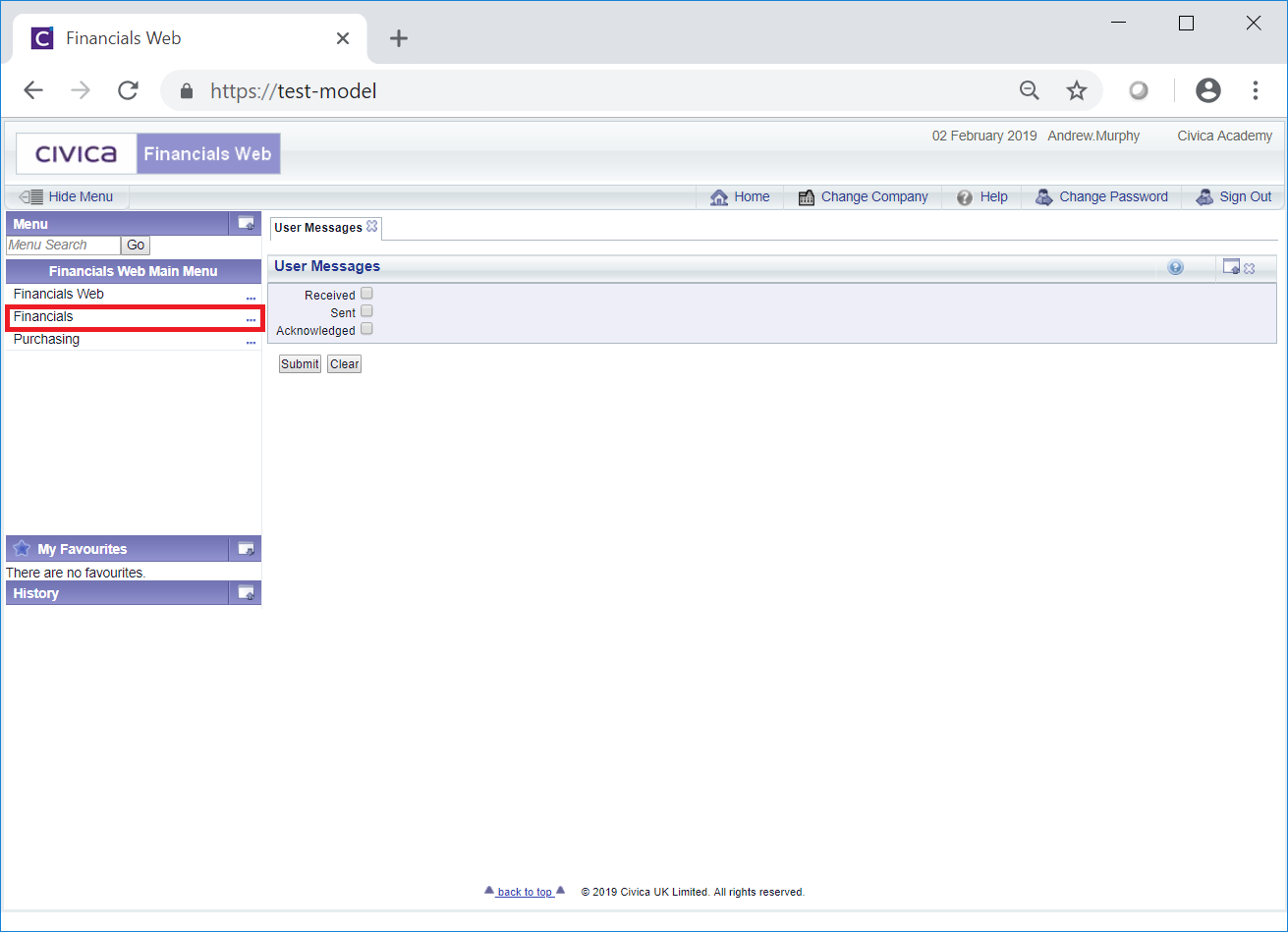
Then the Asset Management menu option:
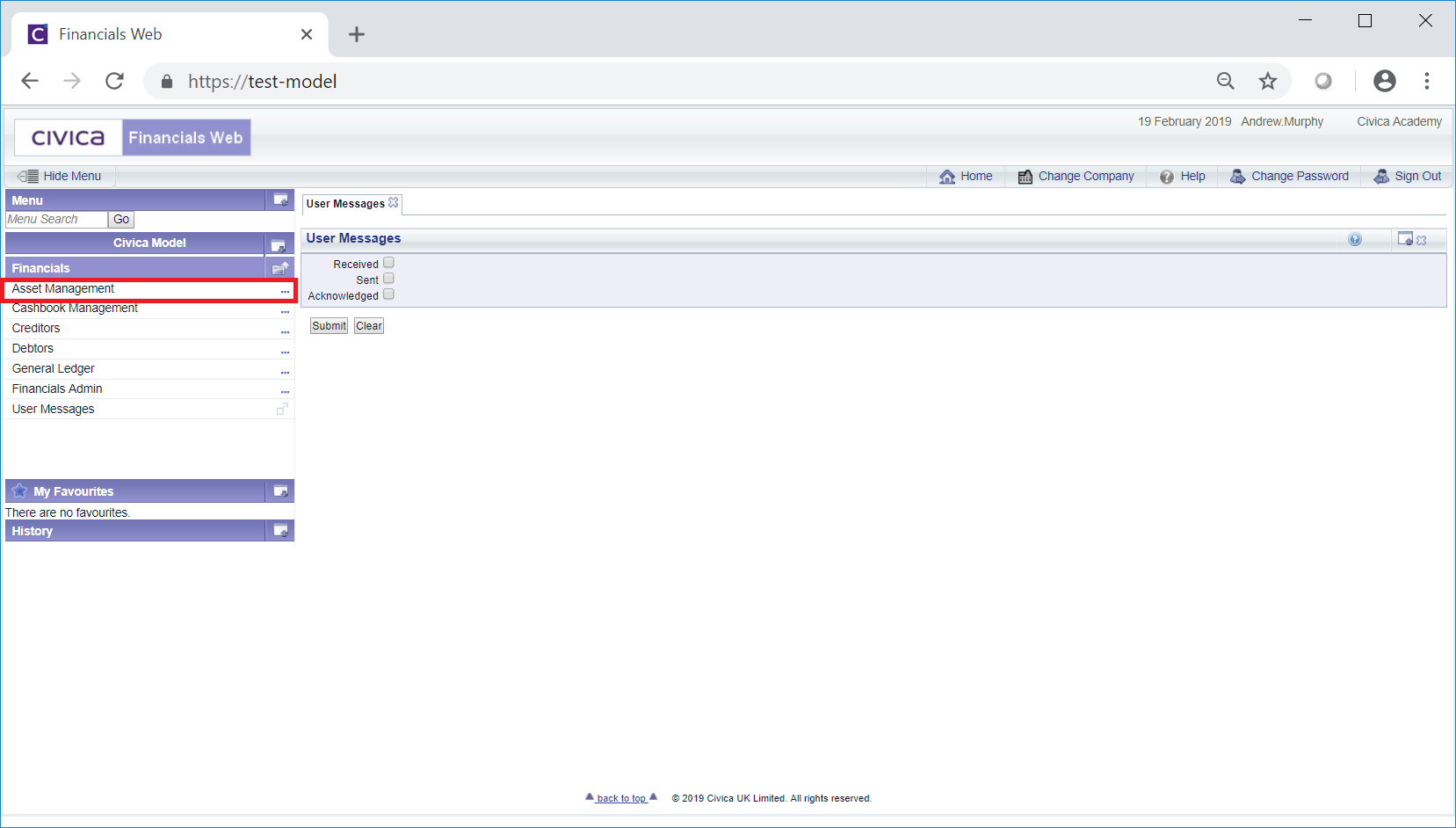
Then the AM Asset Transactions menu option:
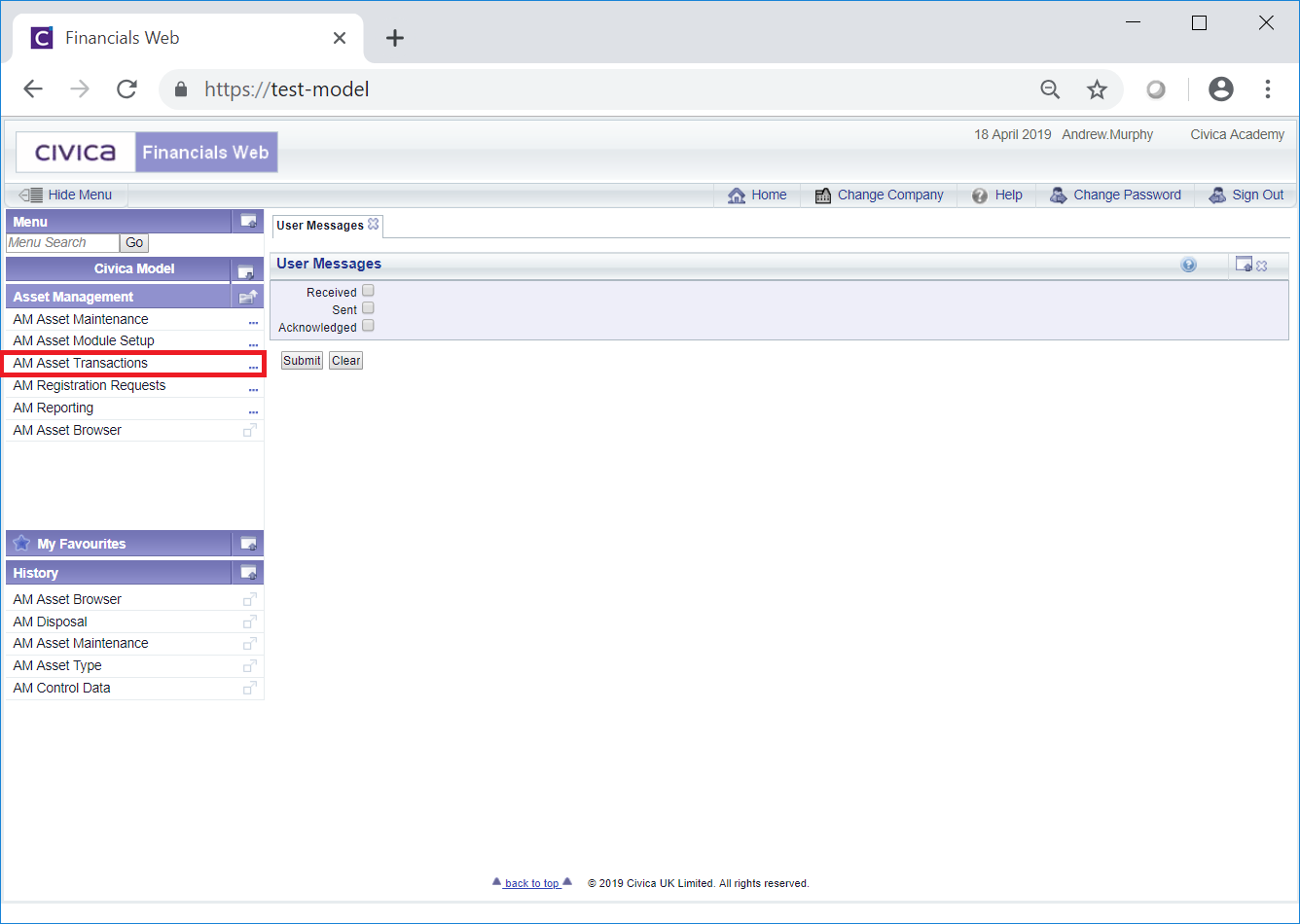
Then the AM Split menu option:
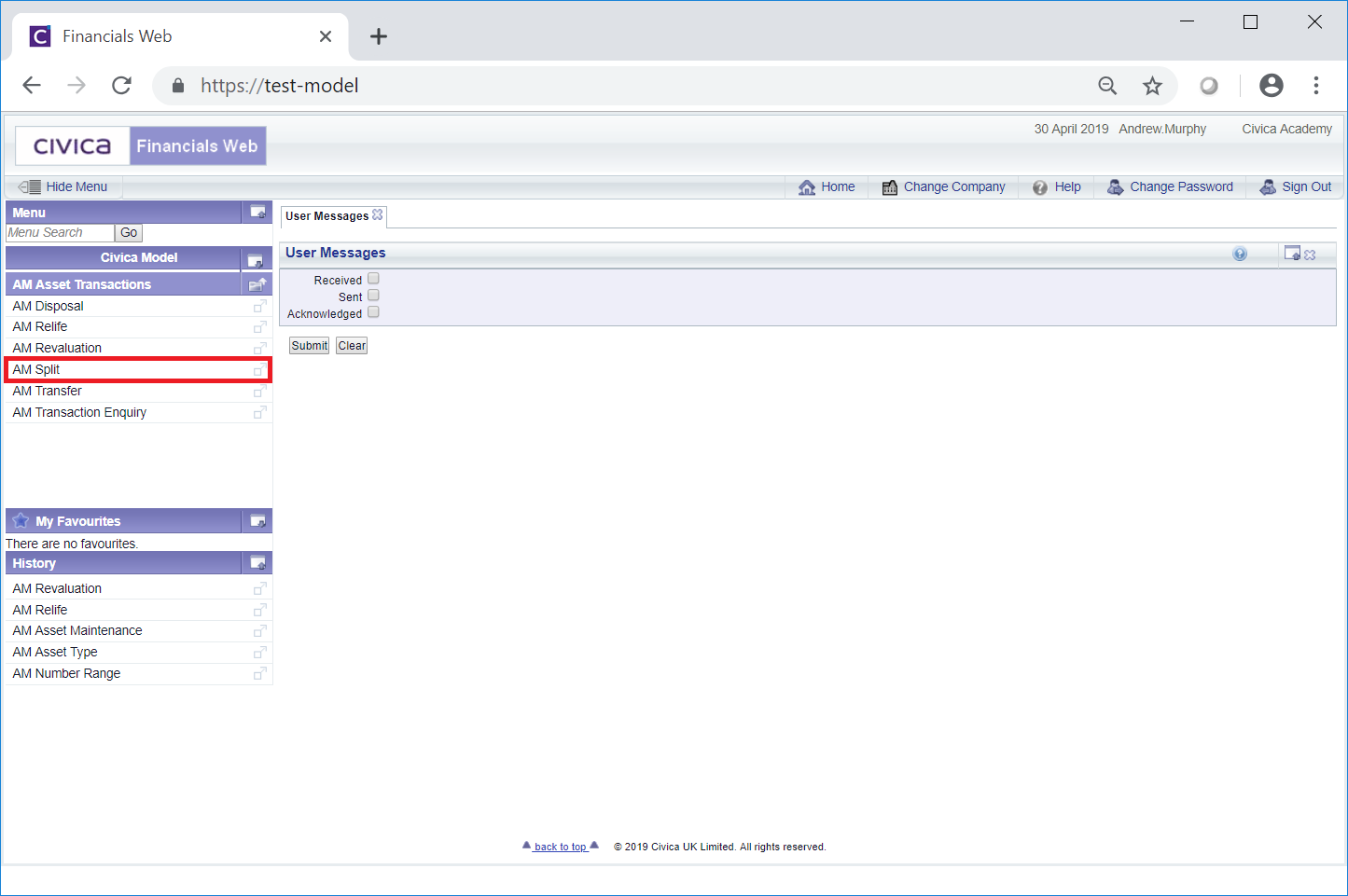
The AM Split form will open:
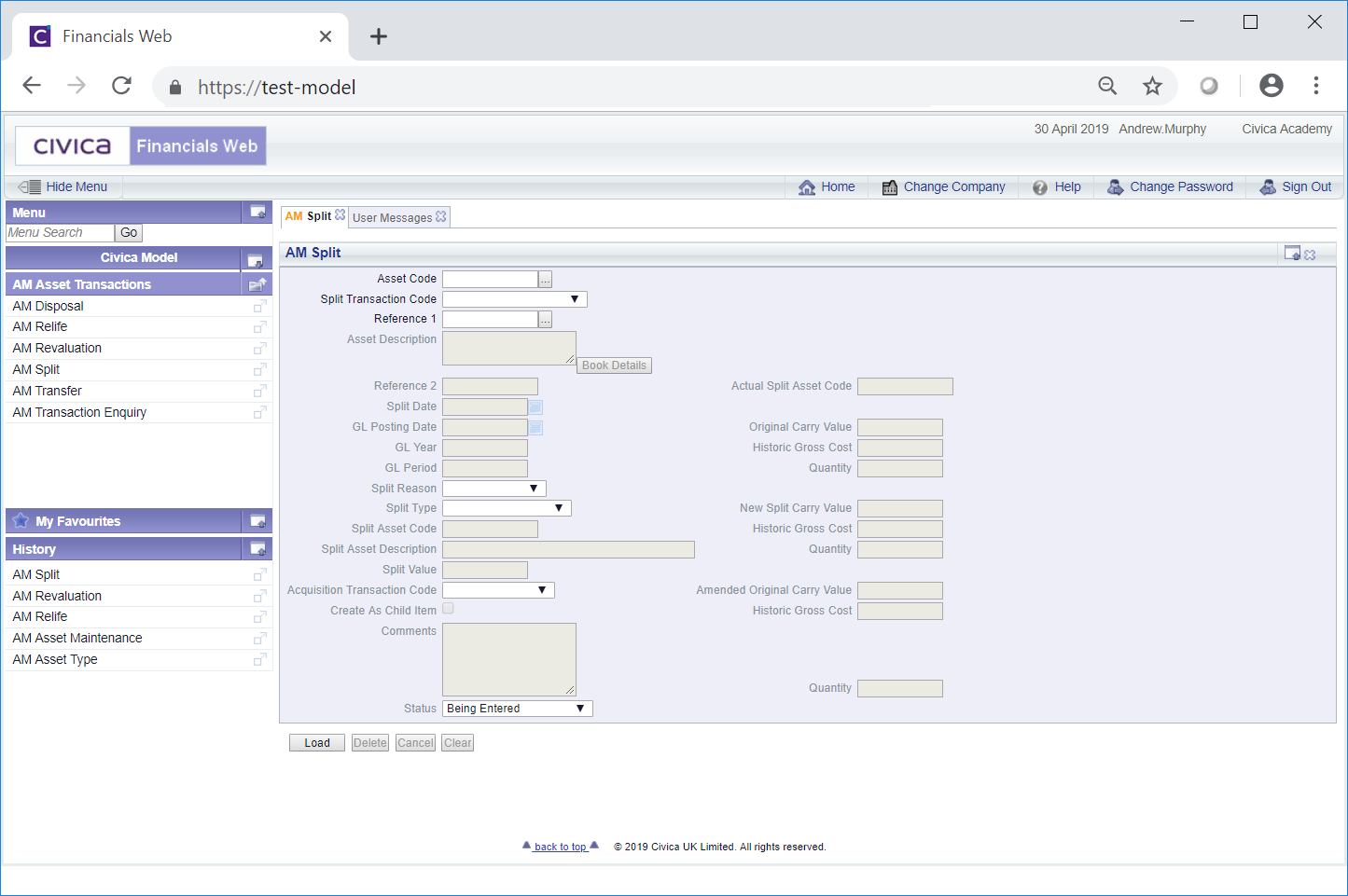
This form can also be accessed by clicking on the  button on the Main tab of the AM Asset Maintenance form, as detailed in the Amending Assets section. In this case certain fields will be populated from the Asset on the AM Asset Maintenance form:
button on the Main tab of the AM Asset Maintenance form, as detailed in the Amending Assets section. In this case certain fields will be populated from the Asset on the AM Asset Maintenance form:
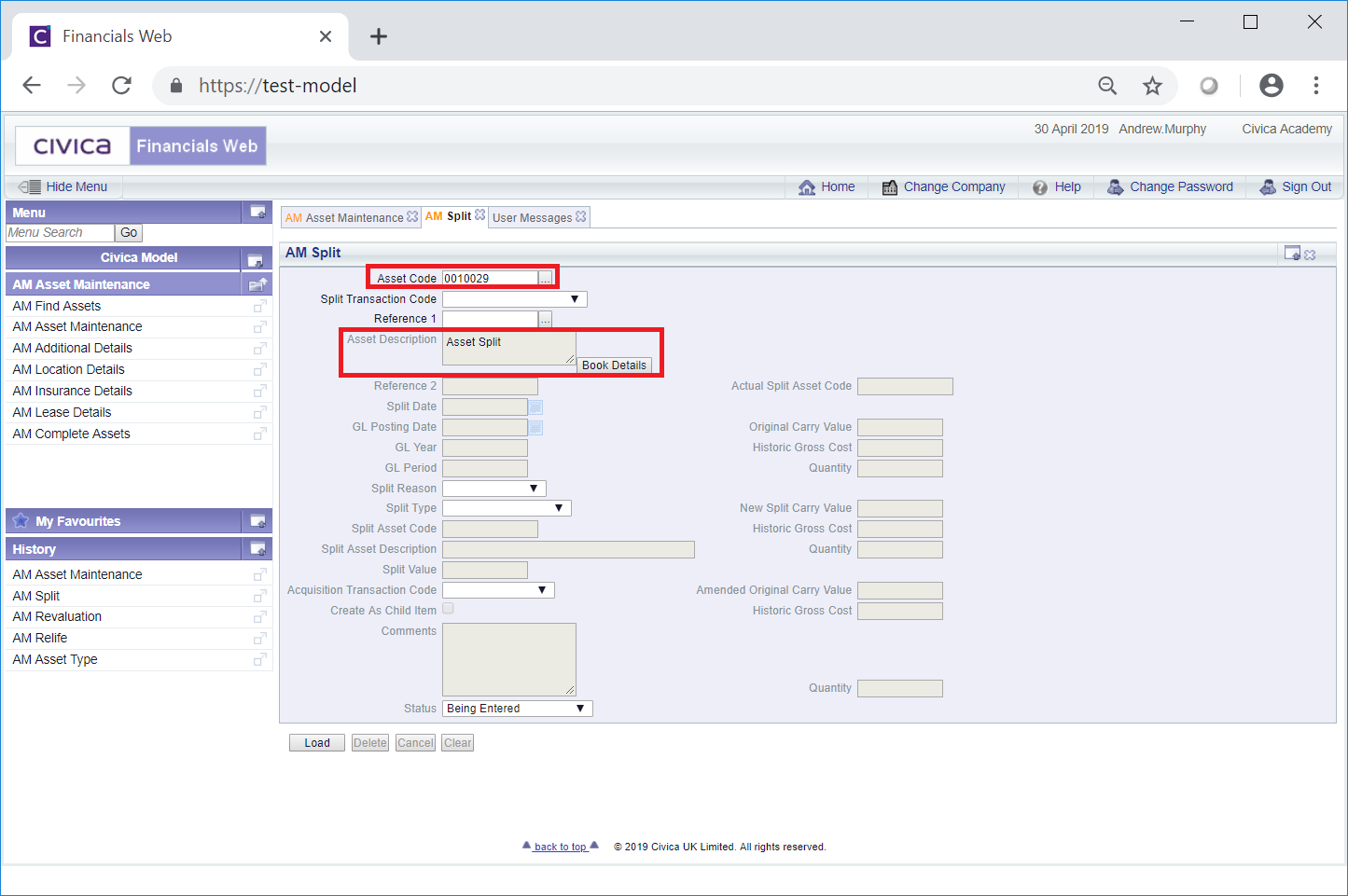
A  button will also be available - clicking on this button will open the AM Asset Book Values Before the Transaction screen, detailing values of the Asset Book before the Split transaction. This screen is further detailed in the Asset Book Values section.
button will also be available - clicking on this button will open the AM Asset Book Values Before the Transaction screen, detailing values of the Asset Book before the Split transaction. This screen is further detailed in the Asset Book Values section.
To create a Split transaction add the code of the required Asset to the Asset Code field, if not already populated. Alternatively click on the Find Asset button located to the right of this field,  . This will open the AM Find Asset form allowing you to search for and select the required Asset. This form is further detailed in the Find Asset section.
. This will open the AM Find Asset form allowing you to search for and select the required Asset. This form is further detailed in the Find Asset section.
Select a code in the Split Transaction Code drop-down field.
A unique transaction reference will need to be added to the Reference 1 field where these are not automatically generated. Where these are generated automatically this field can be left blank. Please note: this field may have a different label dependent on your configuration.
Click on the  button:
button:
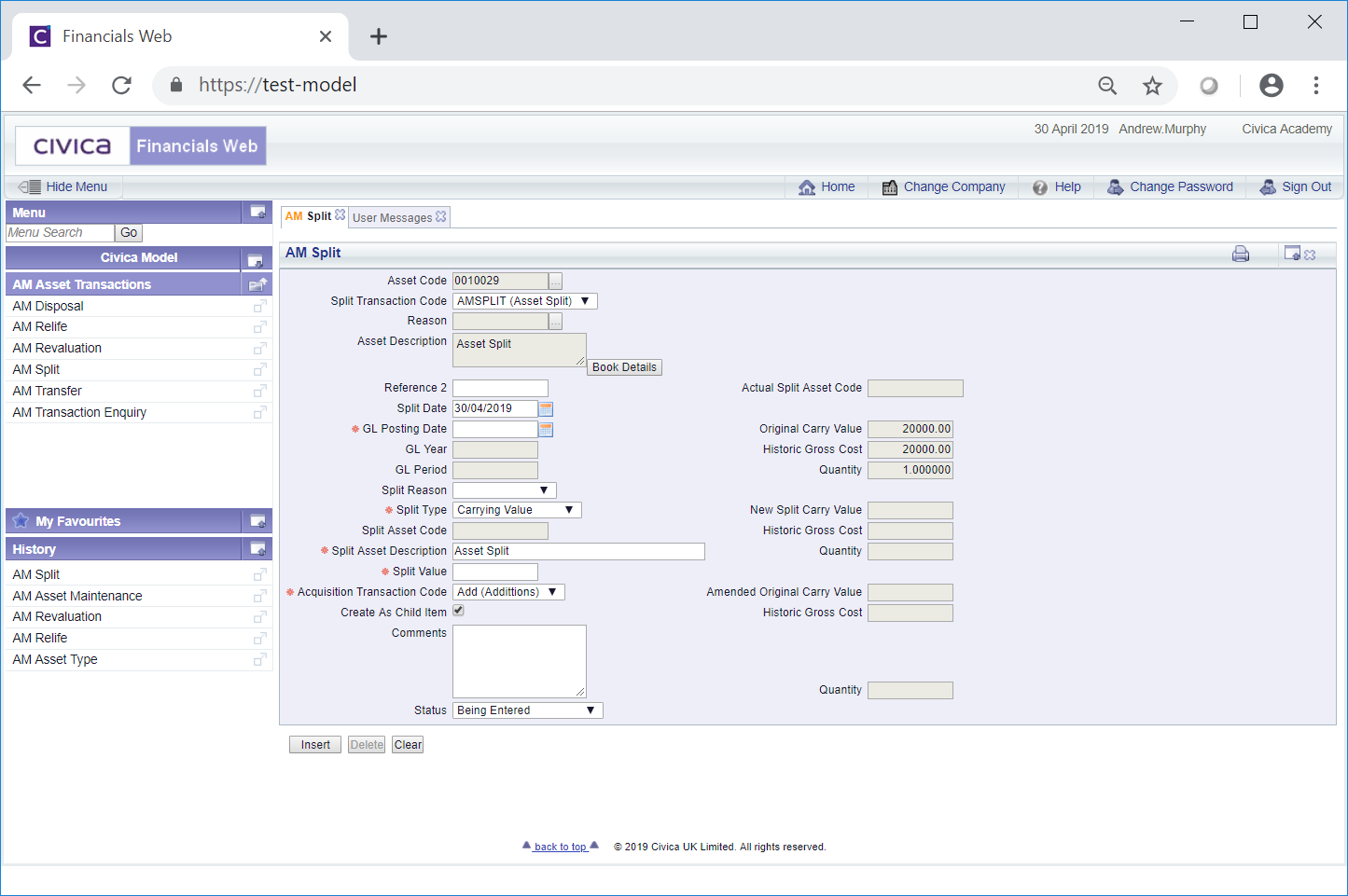
The following fields may be displayed (mandatory fields are notated with a red asterisk *):
- Asset Code: This field will display the code of the Asset to be split and cannot be changed.
- Split Transaction Code: This field will display the transaction code for the Split transaction and cannot be changed.
- Reference 1: This field will contain the reference for the transaction where it has been manually added. Where it is to be automatically generated this field will be blank. The details in this field cannot be changed. Please note: this field may have a different label dependent on your configuration.
- Asset Description: This field will contain the description of the Asset to be split and cannot be changed.
At the bottom right of this field is a  button. Clicking on this button will open the AM Asset Book Values Before the Transaction screen, detailing values of the Main Asset Book before the Split transaction. This screen is further detailed in the Asset Book Values section.
button. Clicking on this button will open the AM Asset Book Values Before the Transaction screen, detailing values of the Main Asset Book before the Split transaction. This screen is further detailed in the Asset Book Values section.
- Reference 2: This is a second reference field that can be added if required. Dependant on your configuration this field may not be displayed and if displayed may have a different label and will either be a mandatory or an optional field.
- Split Date: This field will display the date of the Split and will default to the current Assets Processing Date (normally today's date) but can be changed if required.
- GL Posting Date: Add the date that the Split transaction is to be posted to the General Ledger.
- GL Year: The Year in this field will be determined by the date added to the GL Posting Date field, as detailed immediately above, and will be populated once the
 button is clicked on, as detailed below. You will not be able to change this field directly.
button is clicked on, as detailed below. You will not be able to change this field directly.
- GL Period: The Period in this field will be determined by the date added to the GL Posting Date field, as detailed above, and will be populated once the
 button is clicked on, as detailed below. You will not be able to change this field directly.
button is clicked on, as detailed below. You will not be able to change this field directly.
- Split Reason: Select on option from this drop-down field to provide a reason for the transaction if required. Reasons are defined as detailed in the Reasons section within Asset Admin.
- Split Type: Select on option for the type of Split from this drop-down field. The options are:
- Carrying Value
- Historic Gross Cost
- Percentage
- Quantity
The option selected will define how the Asset is to be split.
- Split Asset Code: This field can be used to add the code of the new Asset where it is not being generated automatically. Where this field is not available, the new Asset Code will be generated automatically so can be ignored.
- Split Asset Description: Add a description for the new Asset that will be created due to the split. This will be pre-populated with the description of the original Asset.
- Split Value: Where the Split Type field, as detailed above, is set to Carrying Value or Historic Gross Cost, a value should be added to this field. Where it is set to Percentage a percentage amount should be added and where set to Quantity a quantity amount should be added.
Apart from where the Percentage option is used, the entered value or amount will be used to calculate the percentage of the Asset that is split, subject to rounding. In rare cases the entered amount added where the Split Type is Carrying Value or Historic Gross Cost, may be adjusted slightly to retain data integrity.
Where the Percentage option is used the percentage amount added will be used directly to calculate the value of the new split Asset.
- Acquisition Transaction Code: An Acquisition Transaction Code will be needed to make the new split Asset a Live Asset. Ensure the required code is included in this field. Other options may be available in the drop-down list.
- Create as Child Item: This option will be selected by default but can be de-selected as required. Where selected the new split Asset will become a Child of the Asset it has been split from.
- Comments: Dependant on your configuration this field may not be displayed. Where it is displayed it will either be a mandatory field, in which case further details on the transaction must be added, or an optional field, in which case further details may be added or it can be left blank.
- Status: This will be set to
 and you will not be able to change this field.
and you will not be able to change this field.
The following fields are also displayed on the right of the form:
- Actual Split Asset Code: Once the transaction has been created and completed this field will be populated with the code of the new Asset that has been split from the original Asset.
The following fields will be displayed immediately underneath the Actual Split Asset Code field:

These are:
- Original Carrying Value: This field will contain the original Carrying Value that is on the Asset Book in the original Asset before the Split transaction and cannot be changed. This amount can be found by clicking on the
 button as detailed above.
button as detailed above.
- Historic Gross Cost: This first Historic Gross Cost field will contain the Historic Gross Cost that is on the Asset Book of the original Asset before the Split transaction and cannot be changed. This amount can be found by clicking on the
 button as detailed above.
button as detailed above.
- Quantity: This first Quantity field will contain the amount in the Quantity field on the AM Asset Maintenance form of the original Asset before the Split transaction and cannot be changed.
The next set of fields are as follows:

These are:
- New Split Carry Value: This field will be blank and you will not be able to change it. Once the transaction is created, this field will be populated with the new Carry Value for the Asset that has been split from the original Asset. This amount can be found by clicking on the
 button on the new Asset on the AM Asset Maintenance form once the transaction has been completed.
button on the new Asset on the AM Asset Maintenance form once the transaction has been completed.
- Historic Gross Cost: The second Historic Gross field will be blank and you will not be able to change it. Once the transaction is created this field will be populated with the Historic Gross Cost for the Asset that has been split from the original Asset. This amount can be found by clicking on the
 button on the new Asset on the AM Asset Maintenance form once the transaction has been completed
button on the new Asset on the AM Asset Maintenance form once the transaction has been completed
- Quantity: The second Quantity field will be blank and you will not be able to change it. Once the Asset is split, this field will be populated with the Quantity for the Asset that has been split from the original Asset. This will be added to the Quantity field on the AM Asset Maintenance form for the new Asset once the transaction has been completed.
The last set of field are as follows:

These are:
- Amended Original Carry Value: This field will be blank and you will not be able to change it. Once the Asset is split, this field will be populated with the amended Carry Value for the original Asset. This amount can be found by clicking on the
 button on the original Asset on the AM Asset Maintenance form once the transaction has been completed.
button on the original Asset on the AM Asset Maintenance form once the transaction has been completed.
- Historic Gross Cost: The third Historic Gross Cost field will be blank and you will not be able to change it. Once the Asset is split, this field will be populated with the amended Historic Gross Cost for the original Asset. This amount can be found by clicking on the
 button on the original Asset on the AM Asset Maintenance form once the transaction has been completed.
button on the original Asset on the AM Asset Maintenance form once the transaction has been completed.
- Quantity: The third Quantity field will be blank and you will not be able to change it. Once the Asset is split, this field will be populated with the amended Quantity for the original Asset. This will be added to the Quantity field on the AM Asset Maintenance form for the original Asset once the Split transaction has been completed.
The buttons at the bottom of the form are as follows:
 : Clicking on this button will clear all the fields on the form and no Split transaction will be created. The initial version of the form will be displayed where you can create a new Split transaction or view an existing one.
: Clicking on this button will clear all the fields on the form and no Split transaction will be created. The initial version of the form will be displayed where you can create a new Split transaction or view an existing one. : Click on this button to create the Split transaction:
: Click on this button to create the Split transaction:
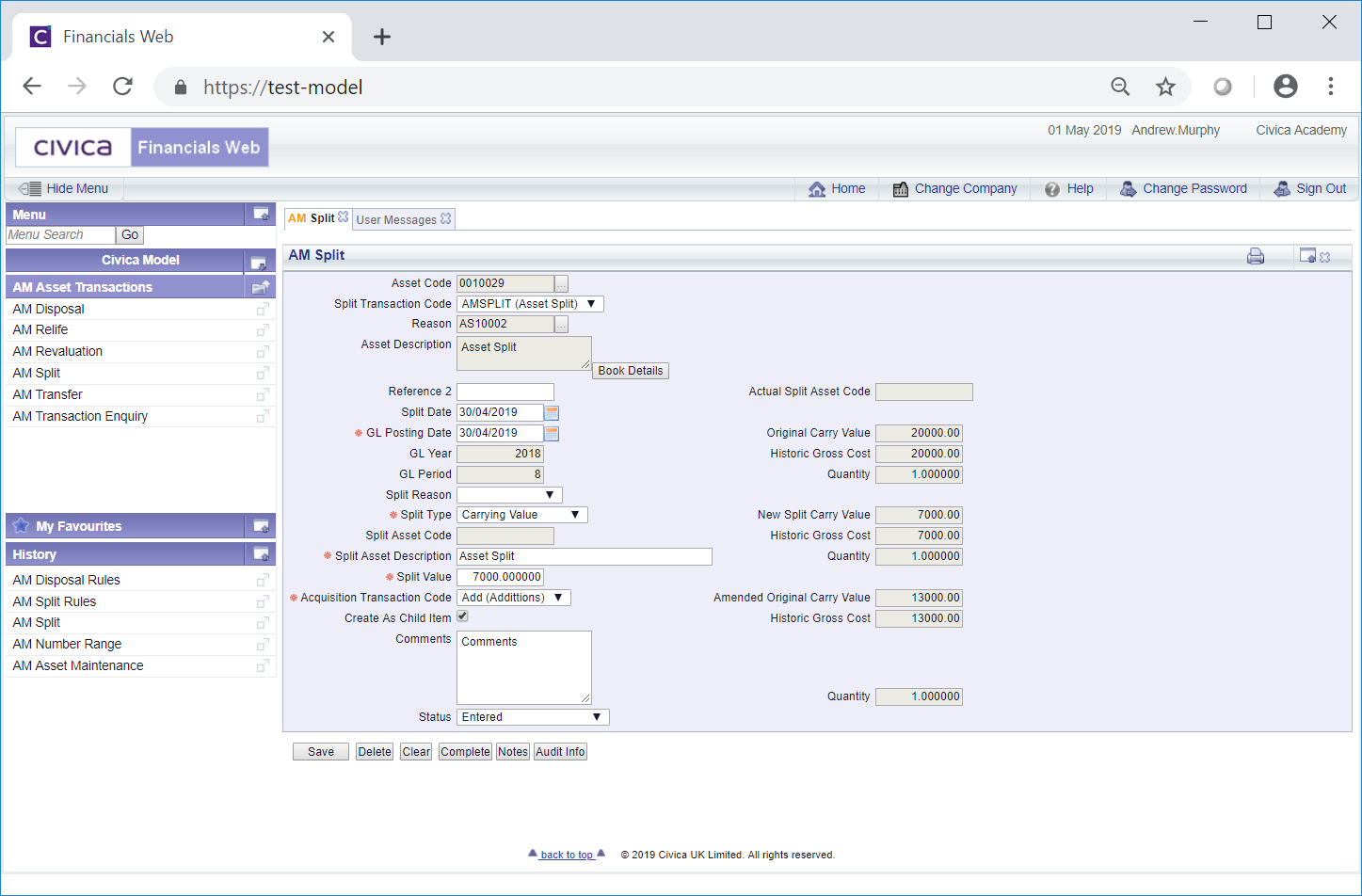
The same fields as detailed above are still available and some can be changed, if required.
You will note that the previously blank fields on the right of the form have now been been populated.
You will also note that the Status of the transaction has now changed to  and that further buttons are now be available at the bottom of the form.
and that further buttons are now be available at the bottom of the form.
These are:
 : Click on this button to save any further changes to the fields on the form.
: Click on this button to save any further changes to the fields on the form. : Click on this button to delete the transaction. A message will be displayed asking for confirmation that the transaction is to be deleted. Please note the transaction can only be deleted where the Status is set to
: Click on this button to delete the transaction. A message will be displayed asking for confirmation that the transaction is to be deleted. Please note the transaction can only be deleted where the Status is set to  .
. : Clicking on this button will clear all the fields on the form. The initial version of the form will be displayed where you can create a new Split transaction or view an existing one.
: Clicking on this button will clear all the fields on the form. The initial version of the form will be displayed where you can create a new Split transaction or view an existing one. : Clicking on this button will allow you to add a note with regard to the Split transaction. This is further detailed in the Notes section.
: Clicking on this button will allow you to add a note with regard to the Split transaction. This is further detailed in the Notes section. : Clicking on this button will open the Audit Info screen, providing audit details of the Split transaction. This is further detailed in the Audit Info section.
: Clicking on this button will open the Audit Info screen, providing audit details of the Split transaction. This is further detailed in the Audit Info section. : Clicking on this button will complete the Split transaction and the form will change to the AM Split Readonly form:
: Clicking on this button will complete the Split transaction and the form will change to the AM Split Readonly form:
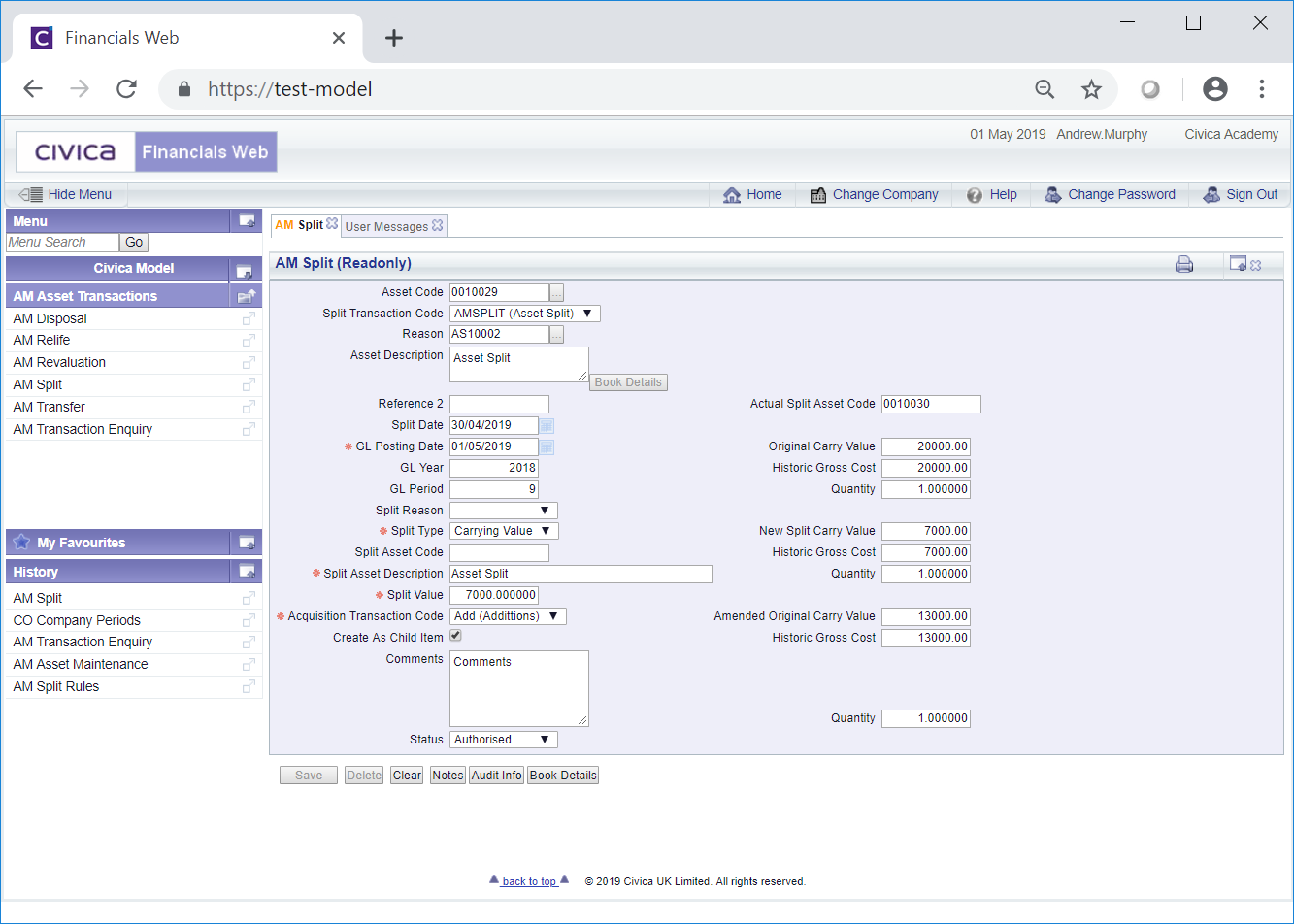
As this form is read only no further changes can be made to the form. The status of the Split transaction will change to  . This form is further detailed in the AM Split (Readonly) form section.
. This form is further detailed in the AM Split (Readonly) form section.
The original Asset will be amended as detailed in the fields above. The newly created Asset will have a Status of  and certain fields can be changed on the new Asset, if required, as detailed on the Amending Assets section.
and certain fields can be changed on the new Asset, if required, as detailed on the Amending Assets section.





 button on the Main tab of the AM Asset Maintenance form, as detailed in the Amending Assets section. In this case certain fields will be populated from the Asset on the AM Asset Maintenance form:
button on the Main tab of the AM Asset Maintenance form, as detailed in the Amending Assets section. In this case certain fields will be populated from the Asset on the AM Asset Maintenance form:
 button will also be available - clicking on this button will open the AM Asset Book Values Before the Transaction screen, detailing values of the Asset Book before the Split transaction. This screen is further detailed in the Asset Book Values section.
button will also be available - clicking on this button will open the AM Asset Book Values Before the Transaction screen, detailing values of the Asset Book before the Split transaction. This screen is further detailed in the Asset Book Values section.![]() . This will open the AM Find Asset form allowing you to search for and select the required Asset. This form is further detailed in the Find Asset section.
. This will open the AM Find Asset form allowing you to search for and select the required Asset. This form is further detailed in the Find Asset section.![]() button:
button:
 button. Clicking on this button will open the AM Asset Book Values Before the Transaction screen, detailing values of the Main Asset Book before the Split transaction. This screen is further detailed in the Asset Book Values section.
button. Clicking on this button will open the AM Asset Book Values Before the Transaction screen, detailing values of the Main Asset Book before the Split transaction. This screen is further detailed in the Asset Book Values section.
 button as detailed above.
button as detailed above. button as detailed above.
button as detailed above.
 button on the new Asset on the AM Asset Maintenance form once the transaction has been completed.
button on the new Asset on the AM Asset Maintenance form once the transaction has been completed. button on the new Asset on the AM Asset Maintenance form once the transaction has been completed
button on the new Asset on the AM Asset Maintenance form once the transaction has been completed
 button on the original Asset on the AM Asset Maintenance form once the transaction has been completed.
button on the original Asset on the AM Asset Maintenance form once the transaction has been completed. button on the original Asset on the AM Asset Maintenance form once the transaction has been completed.
button on the original Asset on the AM Asset Maintenance form once the transaction has been completed.
![]() and that further buttons are now be available at the bottom of the form.
and that further buttons are now be available at the bottom of the form. .
.
![]() . This form is further detailed in the AM Split (Readonly) form section.
. This form is further detailed in the AM Split (Readonly) form section.![]() and certain fields can be changed on the new Asset, if required, as detailed on the Amending Assets section.
and certain fields can be changed on the new Asset, if required, as detailed on the Amending Assets section.